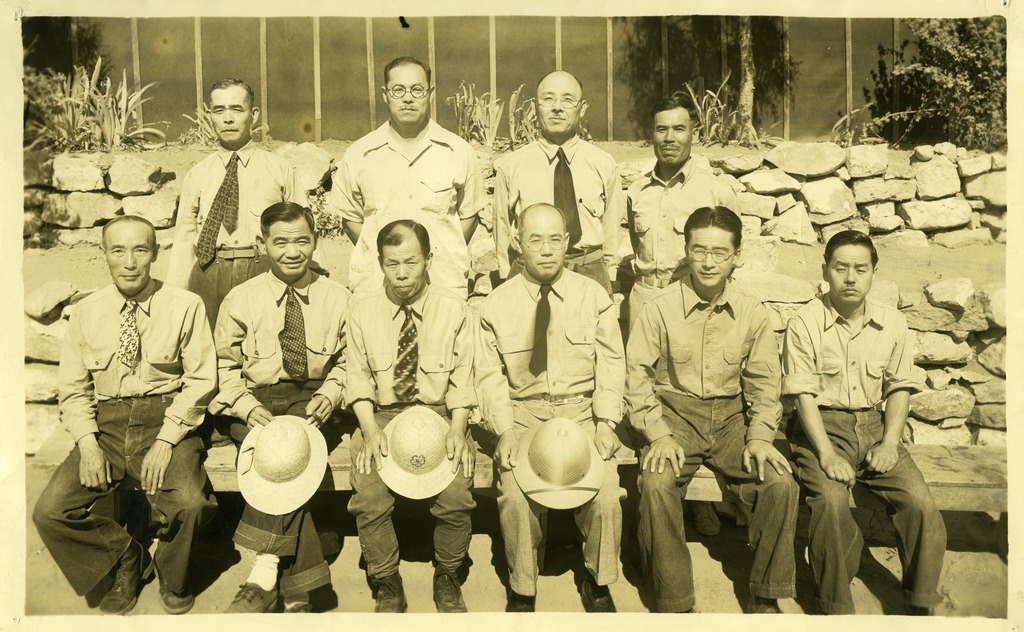August 17, 2021
In this month’s installment of Ask a Historian, Densho Content Director Brian Niiya advises a reader on how to track down records of Japanese Americans arrested as “enemy aliens” and interned in Department of Justice camps during WWII.
Read Brian’s answers to last month’s questions to learn about photographers who documented the camp experience and how Arizona’s history of anti-Japanese agitation influenced many Poston and Gila River incarcerees to resettle elsewhere after WWII.
Lauren writes:
Do you have a recommendation on where to look for family members who were sent to the DOJ camps? I have 2 great-grandfathers who were separated from their families and sent to DOJ camps while the rest of their family went to WRA camps. They were later reunited in the WRA camps, but the final accountability rosters list them both as having entered the WRA camps at the same time as their family.
There seems to be two questions here: (a) How do I find records pertaining to a great-grandfathers’ internment in camps administered by the Justice Department? and (b) How is it that Final Accountability Rosters list the two great-grandfathers as having entered the War Relocation Authority camps together with their families when we know that they had been interned separately?
We’ll tackle the second question first by way of background. As most of you reading this undoubtedly know, thousands of Issei male community leaders were arrested and subsequently interned, the arrests starting hours after the Japanese attack on Pearl Harbor on December 7, 1941. There was a selective internment of those of German and Italian ancestry as well, along with a handful of Issei women, and, in Hawai`i after the declaration of martial law, some Nisei. The quick arrests were based on custodial detention lists that were the result of nearly a decade of surveillance of Japanese American communities. These internees were held in a variety of detention facilities run by the Justice Department and army. Despite these arrests and detentions, President Franklin D. Roosevelt issued Executive Order 9066 on February 19, 1942—which his Justice Department opposed—paving the way for the mass forced removal of 110,000 Japanese Americans from the West Coast over the next several months.
In contrast to Japanese Americans held in WRA concentration camps, those imprisoned by the Justice Department were given hearings to determine whether they would be held for the duration of the war. The Justice Department set up Alien Enemy Hearing Boards—similar boards were set up by the army in martial law Hawai`i—to determine each internee’s fate.
Most of the internees from the West Coast states eventually ended up in one of three large internment camps by the spring of 1942: Missoula, Montana; Fort Lincoln, North Dakota; and Santa Fe, New Mexico. Hearings were held at these sites through the spring and summer of 1942. Though the hearings were stacked against the internees—they could not challenge “evidence” presented against them, for instance—some were granted release or parole. But for Japanese Americans subject to mass removal from the West Coast, “release” or “parole” generally meant a transfer to WRA camps, where they could at least be reunited with their families.
This brings us to the answer to the second question. Recall that most of the Japanese Americans forcibly removed from the West Coast went first to “assembly centers” in the spring and summer of 1942 before going on to the longer term WRA camps in the fall of 1942. With hearings taking place through the spring and summer, those fortunate enough to be released or paroled were sometimes able to rejoin families while they were in an assembly center or sometimes even back home, prior to the family’s forced removal. At Tulare, for instance, there were 164 who transferred from INS detention facilities, 121 of them from Fort Lincoln. The figure was 49 for Tanforan. One of the latter was Dwight Takashi Uchida—the father of children’s book author Yoshiko Uchida—who was able to rejoin his family from Missoula shortly after their arrival at Tanforan. To be clear, most of the internees who were allowed to rejoin their families did so after the move to WRA camps. But a significant minority—likely including the two great-grandfathers of the questioner—did rejoin their families earlier, and thus moved to WRA camps together with them.
This brings us back to the first question. While many individual WRA records are available online, including through Densho’s Names Database, comparable records for both the assembly centers and the Justice Department (and army) administered internment camps are generally not. For the latter, the questioner would need to contact the National Archives and Records Administration (NARA) and request relevant World War II Alien Enemy Detention and Internment Case Files.
For information about requesting such records, see the NARA website. Densho also did a ten-part genealogy workshop last year featuring Linda Harms Okazaki, a professional genealogist specializing in Japanese American family stories. Session Five, “Incarceration Camp Records,” includes more information on the Alien Enemy Detention and Internment Case Files and how to request them. (That part of the presentation starts at around the 28:10 mark.) The files can sometimes be quite large—and thus quite costly to reproduce—and their contents are variable. I’m somewhat abashed to admit that I haven’t done this for my own grandfather, who was arrested in Honolulu on Dec. 7 and subsequently interned. So perhaps this question will inspire me to finally do so.
—
By Brian Niiya, Densho Content Director
[Header: Group photo of internees at Santa Anita, c. 1943-1944. Courtesy of Margaret Hiratsuka.]
